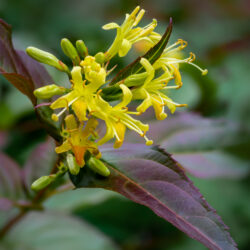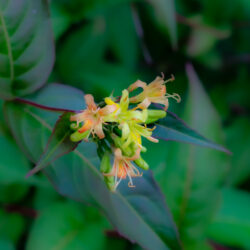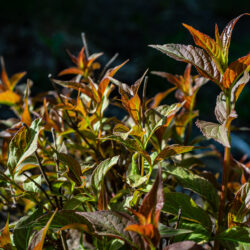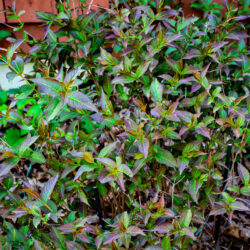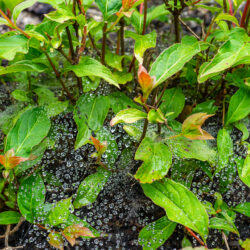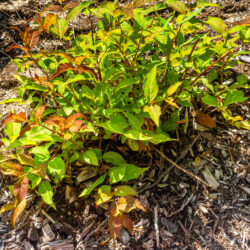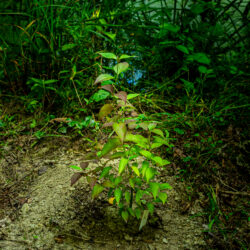Etymology
Diervilla is named after the French surgeon Diereville, who observed the plant with great interest when visiting Canada between 1699-1700. He introduced the plant to Europe upon returning to France; lonicerais from New Latin, after German botanist Adam Lonicerus (Lonitzer).
Native Habitat
Edge habitats and anthropogenic sites (roadsides, clear-cuts, ditches). Native from Newfoundland to Saskatchewan, south to Virginia into the Appalachians.
Garden Uses
With its extended flowering period, bush honeysuckle is an excellent shrub for any garden. Its modest height makes it a great partner for perennials in a conventional border. It is an essential addition to hedgerow plantings, particularly for its ability to blossom when other native shrubs and trees are busy producing fruit. These plants are easy to grow and thrive in average, well-drained soils with dry to medium moisture and in full sun or partial shade. They are quite drought tolerant and tend to freely produce suckers, making them ideal for erosion control or planting in difficult sites like driveway edges. Bush-honeysuckle responds well to thinning of older stems. Notably, it can handle both snowplow damage and snow loads with ease.
Overview
Bush honeysuckle is a small to medium-sized deciduous shrub with shiny green and copper foliage, and delicate, small yellow flowers that are produced all summer and provide an ongoing source of nectar for pollinators. An adaptable plant of edge habitats and disturbed sites, it thrives in a range of soil and light conditions, from dry to seasonally flooded and from sun to shade.
Spread
Diervilla lonicera can spread rapidly via rhizomes, especially in rich, moist soils where it tends to cover a large area quickly. This makes it a valuable tool in combating non-native, invasive bush honeysuckles. Its above-ground spread usually ranges from 2 to 5 feet.
Leaves and Stems
The foliage of bush honeysuckle stands out with its distinctive shades of coppery green and bronze, while the new growth of stems is a brilliant crimson color. These colors persist as the plant produces new leaves and branching stems in abundance throughout the summer and early fall. The branches arch elegantly as they grow longer. In autumn the shrub’s leaves extinguish themselves in a final blaze of yellow, orange, burgundy or scarlet.
Flowers
Small greenish-yellow buds appear in early June and open later in the month. Flowers grow in pairs and trios in lower leaf axils, while the branch tips feature a long-blooming terminal cyme. After pollination, the flowers gradually change color from a deeper yellow to salmon, peach and red, contributing to the shrub's vibrant palette.
Fruit/Seed
The seed is small and dark-colored with a slight grayish bloom when ripe.
Wildlife Associates
Bush honeysuckle flowers benefit butterflies and moths and long-tongued insects that can probe for nectar. In addition to native bumblebees (Bombus affinis, B. terricola, B. vagans), Sphingidae (sphinx moths) sip from bush honeysuckle’s flowers using their long straw-like mouth parts. Smaller short-tongued insects include the Anthophoridae (digger bees), the Megachilidae (leafcutter bees) and the Halictidae (sweat bees, Lasioglossum species). Thickets of bush honeysuckle provide durable cover for ground-nesting birds. Deer are known to browse on bushhoneysuckle, though this often leads to the plant branching out and producing vibrant new growth.
Propagation
This plant spreads readily from stoloniferous roots (horizontal, above-ground stems with roots and shoots forming at the nodes and tip) forming clonal stands. Plants are easy to grow from seed, gathered in fall when the seed capsules dry and turn dark brown. The seed is small, dark-colored with a slight grayish bloom when ripe. Seeds can be sown immediately outdoors, lightly covering the seed with sand or stored dry in the refrigerator and sown in spring.
Garden Location
Entry Garden, Library Garden, Residential Garden (see garden map)
Anecdotal Information
Cultivars are becoming commonplace at the nursery. Obtain straight species plants for optimum ecological benefit.
Sources
Plant Profile by Rachel Emus

